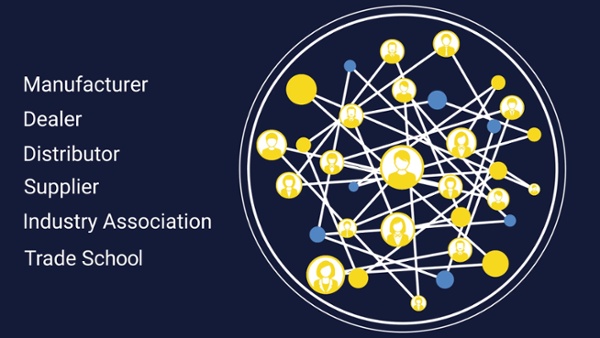Deploying training to your distribution channel is complicated. As explained before, it requires rigid processes, proven methodologies, and company-wide support. To be successful it's important to follow this over-arching, proven framework. Once you understand this framework, and why it’s important, you can confidently deploy a sound training and development strategy. Let's get started!
1. Communication
Your target audience often includes dealer executives, sales, service, parts and finance managers, as well as their respective teams. You’ll need to communicate a clear message of what’s expected of them, why it’s important to them (and to you), and how they can acquire that training.
You should plan for a minimum of monthly communications regarding curriculum and expectations. You should also consider a continual stream of tips and tricks that help them succeed with your training technologies (LMS/PRM/Etc.). A technology-frustrated trainee is not good for your business.
2. Education
When your program goes live be certain you have the courses, curricula and certifications that your target audience needs to be successful. Launching a program without a reasonable amount of content will quickly kill a program.
As you plan your curriculum you should consider both formal courseware such as Instructor-led Training (ILT), Web-based Training (WBT) and Interactive Distance Learning (e.g. “Webex”- style learning), as well as informal training materials such as .pdf files, Word documents, PowerPoint presentations, etc.
3. Motivation
Your audience must be motivated to take your training. Remember, they do not work directly for you and they face competing demands on their time. Do not assume that they are naturally motivated to become certified or improve their performance through learning.
If you build it, they may not come. You need to look seriously at what will motivate them to become thoroughly engaged with your training. With this audience the best approach is usually a carrot, such as pay increases tied to certification levels, or a reward such as points towards gifts.
4. Measurement
Know which KPI’s (Key Performance Indicators) are important to you, before you begin your program. And then make sure you have the technology to provide the reports that will measure those KPI’s. Your technology should also feature dashboard capabilities that will allow you to keep your finger on the pulse of your program at any time and in real time, and on desktop, tablet and smartphone. Measurement is important to your success, and it’s important to keeping your target audience fully engaged.
Have you heard about FUSE? A digital ecosystem for the manufacturing industry
FUSE is designed to help manufacturers:
- Engage effectively with all constituents from supplier to dealer, and most importantly the customer, to strengthen relationships and provide exchanges of value.
- Generate revenue streams by reaching new audiences with existing resources and courseware in the FUSE Academy.
- Identify, recruit and support new dealers and distributors, helping them sell and service your brand’s products more effectively.
- Work with trade schools to develop course material to train and certify tomorrow’s technicians.
- Support trade associations to bring more value to members regionally and in specific market sectors.
Learn more today!

